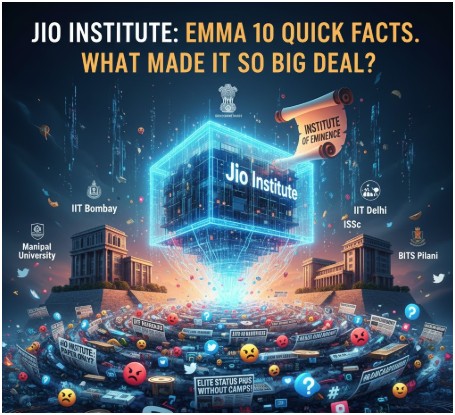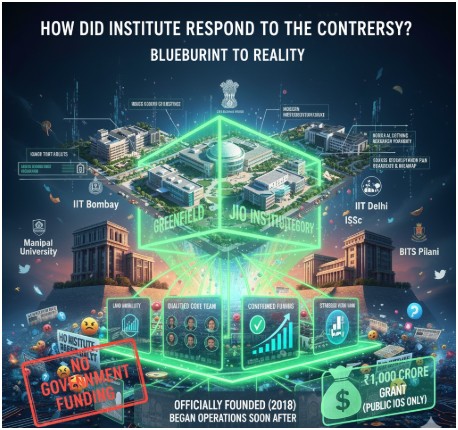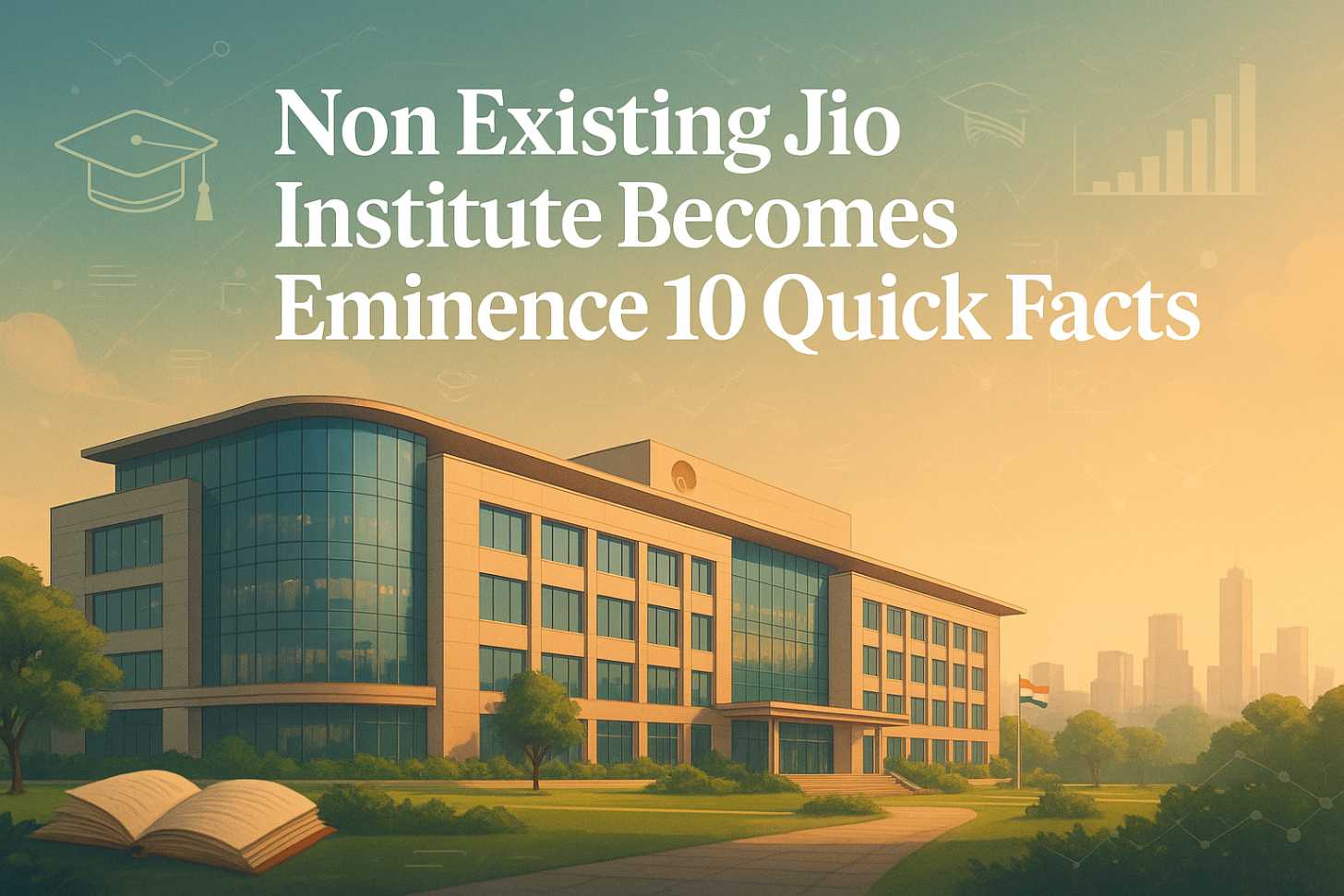I still remember the day my social feed blew up in July 2018. Everyone was talking about something called the Non Existing Jio Institute Becomes Eminence 10 Quick Facts story — a headline that sounded straight out of a satire magazine.
How could an institute that didn’t even exist get tagged as an “Institute of Eminence”? I was curious, confused, and honestly, a little amused. But once I dug deeper, I realized it wasn’t as simple as it looked.
So, here’s my take — part explainer, part coffee-table gossip — on how a yet-to-be-built university ended up in one of India’s biggest education debates.
What Made the Non Existing Jio Institute Becomes Eminence 10 Quick Facts Such a Big Deal?

When the government announced the Institute of Eminence (IoE) list in 2018, it sounded like a move to boost higher education in India.
The list included six names — IIT Bombay, IIT Delhi, and the Indian Institute of Science on the public side, and Manipal University, BITS Pilani, and the proposed Jio Institute on the private side.
Here’s where things got spicy: Jio Institute didn’t have a campus, faculty, or students. It literally existed only on paper.
So when news broke that it had received the same elite status as IITs and IISc, the public went into meltdown mode.
Memes flew, hashtags trended, and the words “academic corruption” and “crony capitalism” began echoing across newsrooms and Twitter threads.
But the real story was slightly more technical — and far more complicated.
Why Was a Non-Existent Institution Even Considered Eminent?

The key phrase here was “greenfield category.” The government had created a special slot for proposed universities that weren’t yet built but showed solid potential on paper.
For this, the Empowered Expert Committee (EEC) had four main boxes to tick before recommending any project:
- Land availability
- A qualified core team
- Confirmed funding
- A strategic vision plan
Among 11 applicants in this greenfield category, Jio Institute was the only one that checked every box.
The head of the committee, N. Gopalaswami, confirmed that Jio’s proposal satisfied all four parameters — which meant it technically qualified.
The logic? If you can imagine an institution that might compete with the world’s top 500 universities in a decade, why not support it before it even opens?
What Exactly Did the Government Approve?

Contrary to the panic headlines, the Jio Institute didn’t actually get the IoE status immediately. It received a Letter of Intent — basically a “conditional pass.”
The Ministry of Human Resource Development (now the Ministry of Education) clarified that Jio had three years to fulfill the expert committee’s requirements before earning full IoE recognition. Think of it as getting an admission offer letter with conditions attached.
Also, unlike public institutes, Jio wasn’t going to receive any government funding. The ₹1,000 crore grant was reserved for the public IoEs only. So, while IIT Delhi got the cash, Jio got a chance — and a giant PR storm.
Why Did Everyone Lose Their Minds Over It?
People weren’t entirely wrong to be upset. The Non Existing Jio Institute Becomes Eminence 10 Quick Facts controversy hit a nerve because it seemed unfair to place an unbuilt private project beside academic legends like IITs and IISc.
Critics — from academics to opposition leaders — argued it was a textbook case of favoritism. The Delhi University Teachers’ Association called it “academic corruption,” while others labeled it “brazen cronyism.”
Many couldn’t believe that an “invisible” university was sharing space with institutions that had decades of research legacy and global recognition.
The government, on the other hand, said this was a forward-thinking decision — one meant to encourage private investment in education.
- Subrahmanyam, then Higher Education Secretary, defended the greenfield idea, saying it was designed to inspire “well-meaning and responsible” players to create world-class universities.
How Did Jio Institute Respond to the Controversy?

To calm the storm, Reliance Foundation quickly shared its blueprint for the proposed university in Navi Mumbai.
The plan showcased modern infrastructure, research focus, and an ambitious roadmap to become globally competitive within a decade.
Later that same year, Jio Institute was officially founded (2018) and began operations soon after.
It started offering postgraduate programs in areas like digital media, data science, and emerging technologies — all aligned with its futuristic vision.
While it didn’t silence the critics completely, it showed that the institution was serious about living up to its early hype.
What Happened to the Institute of Eminence Scheme After That?
The IoE initiative itself hit some bumps. Other private universities like Amrita Vishwa Vidyapeetham and Vellore Institute of Technology that had been shortlisted had to wait years for their formal status.
Bureaucratic delays, a defunct expert committee, and changing policies slowed everything down.
By the time new updates trickled in, most people had moved on from the Jio Institute drama — but the phrase “Non Existing Jio Institute Becomes Eminence 10 Quick Facts” still lives rent-free in many minds as a symbol of India’s strange mix of ambition and irony.
How Does the Jio Institute Compare to Other Eminence Institutes?
| Category | Public Institutions | Private/Greenfield Institutions | Funding |
| Examples | IIT Bombay, IIT Delhi, IISc Bangalore | Manipal University, BITS Pilani, Jio Institute | ₹1,000 crore (public only) |
| Established? | Decades-old institutions | Jio was proposed in 2018 | Conditional status |
| Vision | Boost global rankings | Build new-age global model | Self-funded |
The Jio Institute stood apart as the only one to start from scratch. While that made it controversial, it also made it a fascinating experiment in how India imagines the future of education.
What Can We Learn From the Non Existing Jio Institute Becomes Eminence 10 Quick Facts Saga?
Honestly, the biggest lesson here is that potential can be as powerful as performance — if it’s backed by resources and vision.
Whether or not you agree with the government’s call, the move sparked an important conversation: should we nurture future talent hubs even before they exist, or reward only those that already prove themselves?
In a country where education often struggles between tradition and innovation, the Jio Institute controversy forced everyone to ask: what does “eminence” really mean?
FAQs About the Non Existing Jio Institute Becomes Eminence 10 Quick Facts
1. Why was the Jio Institute selected despite not existing?
It was chosen under the “greenfield” category, meant for proposed universities with strong plans. Jio Institute met all four required criteria — land, funding, a core team, and a clear strategic vision — according to the government’s expert panel.
2. Did Jio Institute actually receive government money?
No. The government only funds public institutions under the IoE scheme. Jio Institute, being private, had to rely entirely on its own resources, mainly from the Reliance Foundation.
3. What kind of courses does Jio Institute offer now?
The institute now runs postgraduate programs in emerging fields like digital media, data science, and artificial intelligence, reflecting its goal of becoming a globally competitive research-driven university.
4. Is Jio Institute officially recognized as an Institute of Eminence now?
It was granted a conditional Letter of Intent in 2018. The full status depends on meeting all government-set benchmarks. As of now, it continues to develop toward that goal.
The Final Bell Rings on the “Eminent” Mystery
If there’s one thing the Non Existing Jio Institute Becomes Eminence 10 Quick Facts story taught me, it’s that public perception can change faster than government paperwork.
What started as a national joke became a serious debate on how India should support innovation in higher education.
I still think the move was gutsy — maybe even reckless — but it showed ambition. Whether Jio Institute becomes the “IIT of the future” or remains a cautionary tale, it’s a reminder that sometimes, dreaming big starts with a blank page.
And who knows? The next “non-existent” idea might just end up shaping the next generation of learning.




